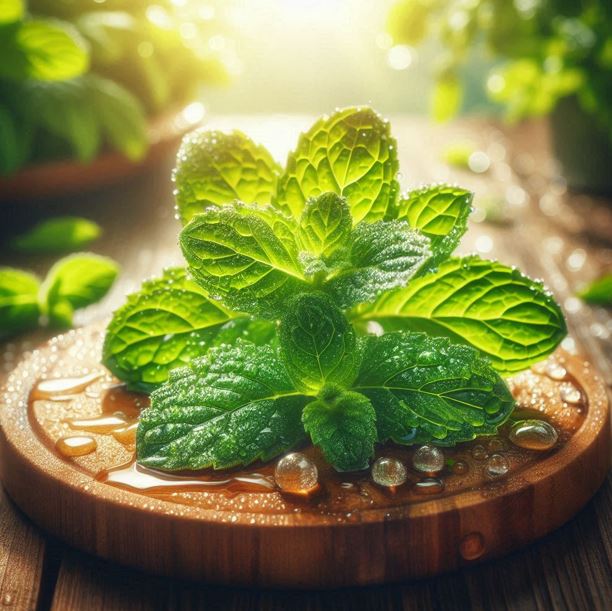The mint
plant (Mentha) is one of nature's most versatile and beneficial herbs,
valued across the globe for its multitude of uses. Here's a comprehensive
overview of everything you might want to know about mint:
1. Types of Mint
Mint
belongs to the Lamiaceae family and includes over 20 species. Some of the most
commonly used varieties are:
- Peppermint (Mentha
piperita):
Known for its strong menthol flavor, widely used in teas, candies, and
medicinal products.
- Spearmint (Mentha spicata): Milder in flavor, often
used in culinary dishes, drinks, and chewing gum.
- Chocolate Mint: A hybrid with a hint of
chocolate flavor, popular for desserts.
- Apple Mint: A sweeter mint variety,
great for salads and teas.
2. Physical Characteristics
- Leaves: Mint has vibrant green,
oval-shaped leaves with serrated edges. The leaves contain aromatic oils
responsible for its signature scent and taste.
- Stems: Square-shaped stems,
typical of the mint family, sometimes slightly hairy.
- Flowers: Small, purple, pink, or
white flowers that grow in clusters, attracting pollinators like bees and
butterflies.
3. Growing Mint
Mint is a
hardy plant that thrives in various environments. It's ideal for beginner
gardeners due to its ease of cultivation:
- Soil: Prefers moist,
well-draining soil rich in organic matter.
- Sunlight: Grows well in partial to
full sunlight.
- Watering: Requires consistent
watering but shouldn't be overwatered.
- Propagation: Easily propagated through
cuttings or runners.
- Care: Mint can be invasive, so
it’s best grown in containers or controlled spaces to prevent it from
spreading excessively.
4. Culinary Uses
Mint is a
culinary favorite worldwide, adding a burst of freshness to dishes and
beverages:
- Drinks: Essential for mojitos,
mint juleps, and refreshing teas.
- Food: Used in salads, chutneys,
sauces (like mint sauce or tzatziki), desserts, and garnishes.
- Flavored Oils: Mint-infused oils for
drizzling over dishes or use in cooking.
5. Medicinal Benefits
Mint has
a long history of use in traditional and modern medicine. Its properties
include:
- Digestive Aid: Relieves indigestion,
nausea, and bloating.
- Respiratory Relief: Menthol in mint helps
clear nasal congestion and soothes coughs.
- Stress Reduction: Calming aroma alleviates
stress and promotes relaxation.
- Headache Relief: Cooling effect of menthol
eases headaches and migraines.
- Oral Health: Antimicrobial properties
combat bad breath and oral bacteria.
6. Cosmetic and Aromatic Uses
Mint’s
refreshing fragrance and benefits extend to personal care and beauty products:
- Skincare: Mint extract is used in
creams and face masks for its cooling and soothing effects.
- Haircare: Promotes scalp health and
is commonly found in shampoos.
- Aromatherapy: The essential oil is used
in diffusers for relaxation and mental clarity.
7. Pest Control
Mint’s
strong scent is a natural deterrent for pests like mosquitoes, ants, and
rodents. Planting mint around gardens helps protect crops without the need for
chemicals.
8. Cultural and Historical Significance
Mint has
played a significant role in various cultures:
- In ancient Greece, mint was
used for bathing and as a symbol of hospitality.
- Egyptians included it in
rituals and medicine.
- In Ayurvedic and traditional
Chinese medicine, mint is valued for its healing properties.
9. Industrial Uses
Mint’s
essential oils are utilized in various industries:
- Pharmaceuticals: In balms, inhalers, and
digestive aids.
- Food and Beverage: As a flavoring agent in
candies, chewing gums, and beverages.
- Personal Care: In toothpaste, mouthwash,
and soaps.
10. Sustainability and Environmental Impact
Mint is a
sustainable crop:
- Requires minimal resources
to grow.
- Enhances soil quality
through its organic matter.
- Helps attract pollinators,
contributing to biodiversity.
Final Thoughts
The mint plant is a remarkable herb with a legacy
that spans culinary, medicinal, and cultural domains. Its adaptability, ease of
use, and myriad benefits make it a cherished plant in homes, gardens, and
industries alike. Whether you’re sipping a refreshing mint tea, garnishing a
dish, or enjoying the calming effects of mint oil, this humble herb truly
enriches our lives in countless ways.





No comments:
Post a Comment